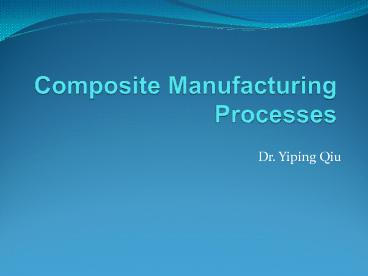Composite Manufacturing Processes - PowerPoint PPT Presentation
1 / 33
Title:
Composite Manufacturing Processes
Description:
Title: Composite Manufacturing Processes Author: yqiu Last modified by: LI Yishuang Created Date: 9/21/1997 9:19:32 AM Document presentation format – PowerPoint PPT presentation
Number of Views:2567
Avg rating:3.0/5.0
Title: Composite Manufacturing Processes
1
Composite Manufacturing Processes
- Dr. Yiping Qiu
2
Composite Manufacturing Processes
- Thermoset composites
- Short fiber reinforced
- Continuous fiber reinforced
- Prepreg
- resin transfer
- Thermoplastic composites
- Commingle
- Impregnated
3
Composite Manufacturing Processes
- Processes
- Hand Lay-up
- Pre-preg forming
- Pressure molding
- Vacuum bagging
- Filament winding
4
Composite Manufacturing Processes
- Processes
- Pultrusion
- Spray method
- Sheet molding
- Bulk molding
- Resin transfer molding
5
Hand lay-up
6
Hand lay-up
- Advantages
- low cost tools
- versatile wide range of products
- Disadvantages
- time consuming
- easy to form air bubbles and disorientation of
fibers - inconsistency
7
Prepreg forming
- Machine
8
Prepreg forming
9
Prepreg forming
- Advantages
- orientation of fibers can be changed
- consistent
- high productivity
- Disadvantages
- continuous process needs more customers
- limited shelf life
- delamination
10
Prepreg forming
11
Pressure molding
12
Pressure molding
- Advantages
- wide range of shapes
- integrate parts
- consistency
- structural stability
- relatively simple
- Disadvantages
- high cost of machine
- time consuming to heat up, cool down and curing
- expensive molds (strong materials required)
- no intricate parts
- large volume of products
13
Vacuum bagging
- Process
14
Vacuum bagging
- Advantages
- simple design
- any fiber/matrix combination
- ok with cheap mold material
- better quality for the cost
- Disadvantages
- cannot be heated up too much
- breeder clothe has to be replaced frequently
- low pressure (760 mm Hg the most)
- slowest speed
- inconsistency
15
Filament winding
16
Filament winding
17
Filament winding
18
Filament winding products
- Compressed air tanks
- High-pressure CO2 tanks and bottles
- Water softener systems
- Rescue air tanks
- Sail boat masts
- Compressed Natural Gas tanks
- Defense/Aerospace systems
- Lightpoles
19
Filament winding
- Advantages
- using existing textile processes.
- quick, easy to handle package.
- parts can have huge size.
- Disadvantages
- spinning speed is limited due to resin
penetration and splashing, traveler speed and
yarn breakage. - curing by heat is not easy to apply.
- shape of the products limited (only cylindrical
possible).
20
Pultrusion
21
Pultrusion
22
Pultrusion
- Advantages
- Automated processes.
- High speed.
- Versatile cross-sectional shape.
- Continuous reinforcement.
- Disadvantages
- Die can be easily messed up.
- Expensive die.
- Mainly thermoset matrix.
23
Spray method
24
Spray method
- Advantages
- Continuous process
- Any materials can be used as mold.
- Error can be corrected by re-spraying.
- Disadvantages
- Slow.
- inconsistency.
- No control of fiber orientation.
- Only one side finished.
- Environmental unfriendly.
25
Sheet molding
26
Sheet molding
- Advantages
- High productivity thus inexpensive
- consistency
- Disadvantages
- low volume fraction.
- Only board can be made.
27
Bulk molding
28
Bulk molding
- Advantages
- Highest volume fraction for short fiber
reinforced composites (50) - Good mechanical properties
- Finish can be applied
- Inserts and attachments possible
- Disadvantages
- High temperature and high pressure
- Random fiber orientation
- Cannot be used for intricate parts
- Staple fibers only.
29
Resin transfer molding
http//www.plastech.co.uk/Mtrtm.html
30
Resin transfer molding
- Advantages
- Components will have good surface finish on both
sides - Selective reinforcement and accurate fiber
management is achievable - Ability to build-in fiber volume fraction
loadings up to 65 - Uniformity of thickness and fiber loading,
uniform shrinkage - Inserts may be incorporated into moldings
- Tooling costs comparatively low
- Uses only low pressure injection
- Low volatile emission during processing
- Ability to produce near net shape moldings
- Process can be automated, resulting in higher
production rates - Ability to mould complex structural and hollow
shapes - Low resultant voids
- Ability to achieve from 0.5mm to 90mm laminate
thickness - Disadvantages
- waste some material (spill)
- curing time long
- hard for intricate parts
31
Vacuum Assisted Resin Transfer Molding
- http//www.futuremediacreations.com/technoire/vart
m.htm
32
Vacuum Assisted Resin Transfer Molding
- Advantages?
- Disadvantages?
33
Filament Placement

